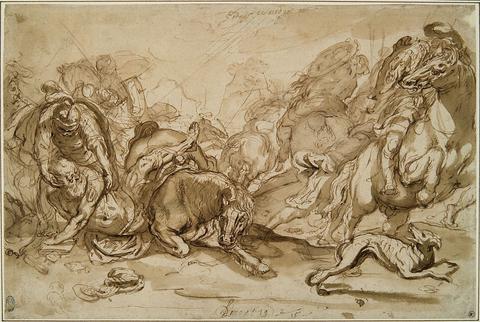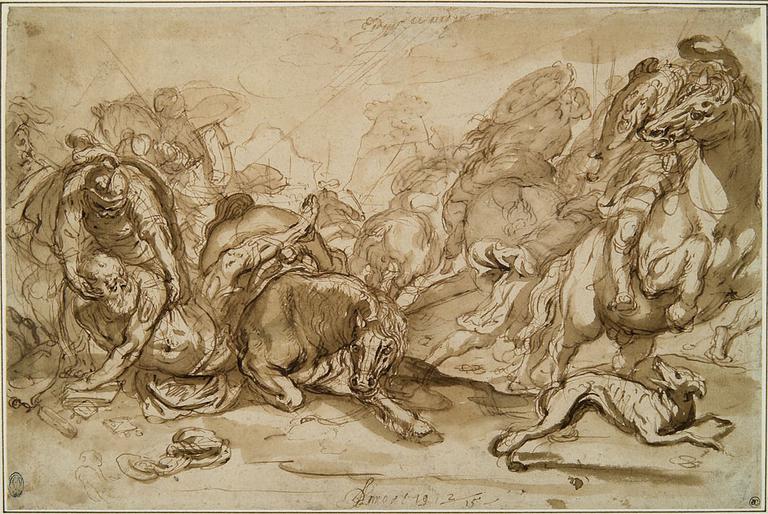
La Conversion de saint Paul
Italie du Nord début du 17ème siècle
1619
Plume, encre brune et lavis brun sur papier, arbre en filigrane ; inscriptions : « Anno 1619 2/15 » en bas au centre, illisible en haut au centre, « G 138 » et « Proccaccini Ercole senior » (par Giuseppe Vallardi) au verso ; 19,4 x 29,6 cm
Provenance :
Giuseppe Vallardi (marque de collection Lugt 1223 en bas à gauche) ; Charles Gasc (marque de collection Lugt 544 en bas à droite) ; galerie Kekko (Van Dyck) ; Canada, collection privée ; Londres, Christie’s, 5 juillet 2011 ; Paris, collection Le Polyptyque ; Paris, collection privée.
La Conversion de saint Paul est un sujet typiquement maniériste ou baroque, tant par l’esprit – la reconquête des âmes – que le style – « le nombre, l’agitation, le tumulte, les corps entremêlés » (Walter Friedlaender, Maniérisme et anti-maniérisme, New York, 1957). Les papes de la Contre-Réforme prennent souvent le nom de « l’apôtre des gentils ». C’est sous le pontificat de Paul III Farnèse (1540-1549) que Michel-Ange, à la Cappella Paolina du Vatican, et Salviati, par la gravure, établirent les sources iconographiques dont s’inspireront deux générations d’artistes.
Ce dessin, daté précisément de 1619, sous le pontificat cette fois de Paul V Borghèse (1605-1621), est en revanche difficilement localisable. La paix d’Augsbourg (1553-1618), avant la guerre de Trente Ans (1618-1648) avait amené un calme relatif dans l’empire des Habsbourg, hanté par les rivalités entre catholiques et protestants, et permis, du sud au nord de l’Europe, une circulation sans précédent non seulement des œuvres mais des artistes.
Le soldat casqué relevant saint Paul âgé et barbu, ainsi que le cheval cabré, se retrouvent dans la Conversion de saint Paul peinte par le flamand Hans Speckaert en 1570-1577 (Musée du Louvre) ; le cheval à terre et le casque à plume non loin de lui, dans celle peinte par Rubens, juste avant ou pendant son premier passage à Rome en 1601-1602 (collection des Princes de Liechtenstein). Cette dernière œuvre figurant dans l’inventaire de Nicolas Rockox en 1640 se trouvait probablement déjà à Anvers en 1619. Il ne semble pas que l’une ou l’autre ait été reproduite par la gravure. On doit donc supposer que notre dessinateur soit passé par Anvers (ou moins probablement que Rubens et lui se soient inspirés d’une source commune inconnue) et par ailleurs en des lieux (Bruxelles, Düsseldorf, Munich, Rome) où l’œuvre de Speckaert avait essaimé.
La paternité de Van Dyck, avancée par un précédent propriétaire de l’œuvre, était logiquement défendable, mais ne résiste pas à l’examen graphique. Nous conclurons que ce dessin se situe au confluent, encore anonyme, du maniérisme nordique tant prisé par l’empereur Rodolphe II (mort en 1612 mais dont le frère l’archiduc Albert, gouvernera les Pays-Bas jusqu’en 1621) et du baroque flamand qu’incarnait génialement, depuis son retour d’Italie fin 1608, Rubens. Il a fait partie de deux collections importantes au 19ème siècle, celle du milanais Giuseppe Vallardi, conservateur à la Biblioteca Ambrosiana, et celle du parisien Charles Gasc, sous le Second Empire.
